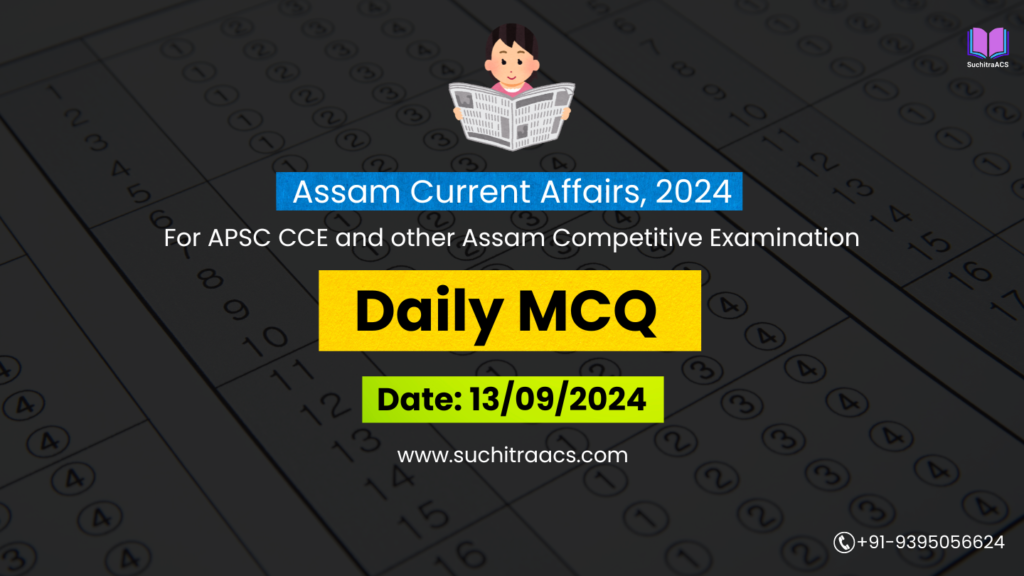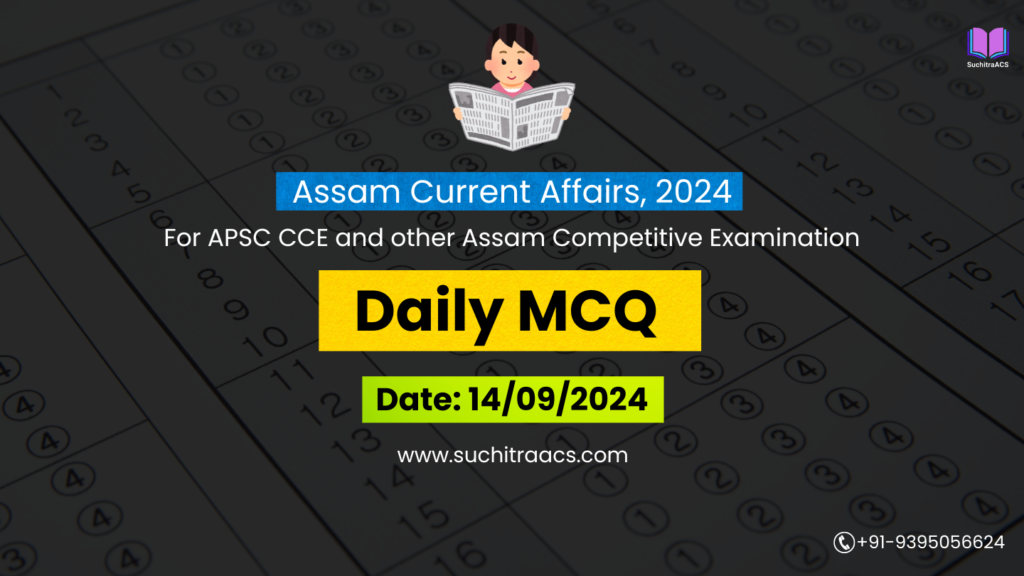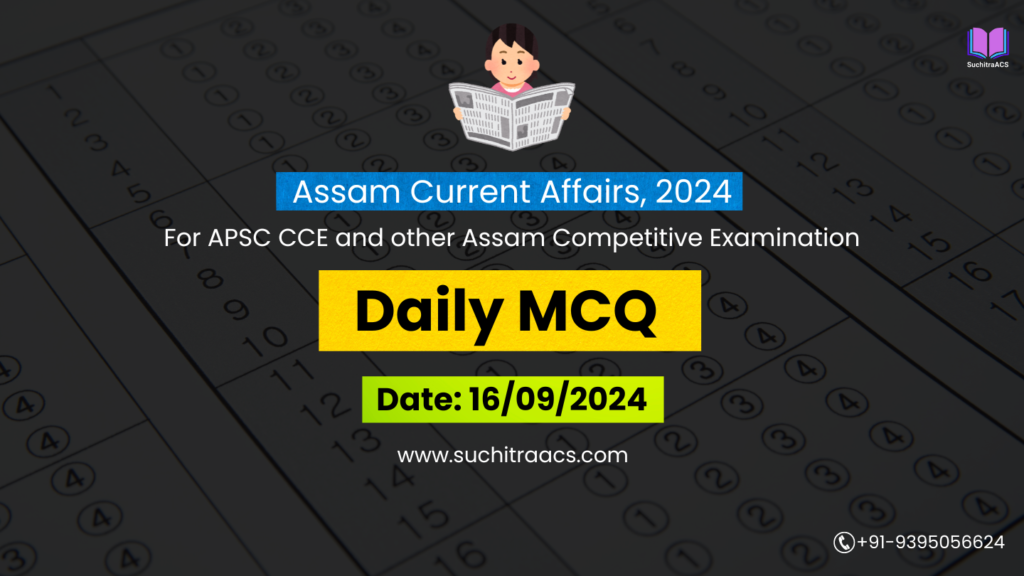APSC MCQs / APSC Prelims Practice Questions based on Assam Tribune (Daily) – 08/03/2025
For APSC CCE and other Assam Competitive examinations aspirants, practicing Daily MCQs is vital. This blog covers most important Prelims questions from the Assam Tribune today (08-03-2025). These issues are key for both APSC Prelims syllabus, offering insights into the important topics of current affairs.
APSC MCQs / APSC Prelims Practice Questions (Date: 08/03/2025)
Topic 1: HC Allows PWD to Carry Out Ancillary Works at Kamakhya
Question 1
Which of the following statements regarding Kamakhya Temple is/are correct?
- Kamakhya Temple is dedicated to Goddess Durga and is one of the 12 Jyotirlingas in India.
- It is associated with Tantric traditions and Shakti worship.
- The temple is located on Nilachal Hill in Guwahati, Assam.
Select the correct answer using the code below:
a) 1 and 2 only
b) 2 and 3 only
c) 1 and 3 only
d) 1, 2, and 3
✅ Answer: b) 2 and 3 only
Explanation:
- Statement 1 is incorrect: Kamakhya Temple is not a Jyotirlinga, but one of the Shakti Peethas, where parts of Goddess Sati’s body are believed to have fallen.
- Statement 2 is correct: Kamakhya Temple is famous for Tantric rituals and Shakti worship traditions.
- Statement 3 is correct: It is located on Nilachal Hill in Guwahati, Assam.
Question 2
Which of the following laws govern the protection and development of heritage sites in India?
- The Ancient Monuments and Archaeological Sites and Remains Act, 1958
- The Environment Protection Act, 1986
- The Public Works Department (PWD) Act, 1925
- The Forest Conservation Act, 1980
Select the correct answer using the code below:
a) 1 and 2 only
b) 1 and 4 only
c) 1, 2, and 4 only
d) 1, 2, 3, and 4
✅ Answer: c) 1, 2, and 4 only
Explanation:
- The Ancient Monuments and Archaeological Sites and Remains Act, 1958 regulates construction and renovation in heritage zones.
- The Environment Protection Act, 1986 applies to projects affecting eco-sensitive heritage sites.
- The Forest Conservation Act, 1980 is relevant when heritage sites are located in forest areas.
- The PWD Act, 1925 does not exist as a national law for heritage protection.
Topic 2: Excavation at Dhekiajuli’s Gupteswar Devalaya
Question 3
The recent excavation at Gupteswar Devalaya in Dhekiajuli, Assam, is expected to provide new insights into which of the following?
- The Kamarupa Kingdom’s religious architecture
- The spread of Vaishnavism and Shaivism in medieval Assam
- The Harappan civilization’s influence in Northeast India
Select the correct answer using the code below:
a) 1 and 2 only
b) 2 and 3 only
c) 1 and 3 only
d) 1, 2, and 3
✅ Answer: a) 1 and 2 only
Explanation:
- Statement 1 is correct: The temple ruins suggest architectural styles linked to the Kamarupa Kingdom (4th–12th century CE).
- Statement 2 is correct: The presence of Shaivite and Vaishnavite inscriptions shows religious influence.
- Statement 3 is incorrect: There is no evidence of Harappan civilization’s influence in Assam.
Question 4
Which of the following sites in Assam are known for their ancient temple architecture?
- Da Parbatia
- Madan Kamdev
- Sivasagar Ahom Monuments
- Pobitora Wildlife Sanctuary
Select the correct answer using the code below:
a) 1 and 2 only
b) 1, 2, and 3 only
c) 3 and 4 only
d) 1, 2, 3, and 4
✅ Answer: b) 1, 2, and 3 only
Explanation:
- Da Parbatia (6th century CE): Oldest known stone temple ruins in Assam.
- Madan Kamdev (10th–12th century CE): Known as the “Khajuraho of Assam” due to its sculptures.
- Sivasagar Ahom Monuments: Though built later (17th century CE), they are important historical sites.
- Pobitora Wildlife Sanctuary is known for Indian rhinos, not temple ruins.
Topic 3: India Voices Concern Over Bangladesh Freeing ‘Violent Extremists’
Question 5
Which of the following terrorist organizations are known to operate in Bangladesh and Northeast India?
- Harkat-ul-Jihad-al-Islami (HuJI-B)
- Jamaat-ul-Mujahideen Bangladesh (JMB)
- United Liberation Front of Asom (ULFA)
- Lashkar-e-Taiba (LeT)
Select the correct answer using the code below:
a) 1 and 2 only
b) 2 and 3 only
c) 1, 2, and 3 only
d) 1, 2, 3, and 4
✅ Answer: c) 1, 2, and 3 only
Explanation:
- HuJI-B and JMB are Bangladesh-based extremist groups with past links to attacks in India.
- ULFA is a Northeast India-based insurgent group, not a terrorist outfit in Bangladesh.
- LeT operates mainly in Pakistan and Kashmir, not in Bangladesh.
Question 6
Which of the following agreements govern Indo-Bangladesh border security and counterterrorism cooperation?
- Land Boundary Agreement (LBA), 2015
- Mutual Legal Assistance Treaty (MLAT)
- SAARC Regional Anti-Terrorism Mechanism
- QUAD Counterterrorism Initiative
Select the correct answer using the code below:
a) 1 and 2 only
b) 1, 2, and 3 only
c) 2 and 4 only
d) 1, 3, and 4 only
✅ Answer: b) 1, 2, and 3 only
Explanation:
- LBA (2015): Resolved land disputes along the Indo-Bangladesh border.
- MLAT: Allows legal cooperation in extradition and counterterrorism.
- SAARC Regional Anti-Terrorism Mechanism: Aims to counter regional extremism.
- QUAD (India, US, Japan, Australia) is not directly involved in Indo-Bangladesh security.
Topic 4: Rabha Hasong Autonomous Council Polls Announced
Question 7
The Rabha Hasong Autonomous Council (RHAC) is responsible for governing which of the following aspects in its jurisdiction?
- Cultural and linguistic preservation of the Rabha community
- Regulation of land rights and resource management
- Law and order and criminal justice administration
Select the correct answer using the code below:
a) 1 and 2 only
b) 2 and 3 only
c) 1 and 3 only
d) 1, 2, and 3
✅ Answer: a) 1 and 2 only
Explanation:
- RHAC focuses on cultural, linguistic, and land rights issues for the Rabha community.
- Law and order remains under Assam’s state government, not the council.
Question 8
Which of the following statements about tribal self-governance in Assam is/are correct?
- The Rabha Hasong Autonomous Council (RHAC) is governed under the Sixth Schedule of the Constitution.
- The Bodoland Territorial Region (BTR) enjoys greater financial and legislative autonomy than RHAC.
- Autonomous Councils in Assam function under state-specific tribal governance laws.
Select the correct answer using the code below:
a) 1 and 2 only
b) 2 and 3 only
c) 1 and 3 only
d) 1, 2, and 3
✅ Answer: b) 2 and 3 only
Explanation:
Statement 3 is correct: Assam’s autonomous councils are governed by state laws, unlike Sixth Schedule areas.
Statement 1 is incorrect: RHAC is not under the Sixth Schedule. It is governed by state laws.
Statement 2 is correct: BTR (Bodoland) has more legislative powers under the Sixth Schedule.
 APSC Prelims Crash Course, 2025
APSC Prelims Crash Course, 2025
at most affordable rate in Assam!

🔔 Join Our WhatsApp Study Group!
For exclusive access to premium quality content, including study materials, current affairs, MCQs, and model answers for APSC CCE and other Assam competitive exams.
Click here to join: SuchitraACS Study WhatsApp Group
📚 Want to know more about SuchitraACS’s most affordable courses?
Click here to know more: SuchitraACS Courses for APSC CCE and Assam Competitive Examinations




